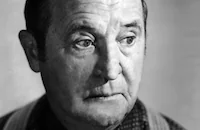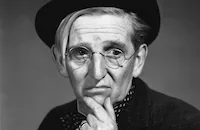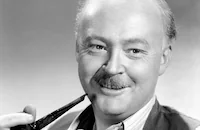The Great Rupert

Brief Synopsis
Cast & Crew
Irving Pichel
Jimmy Durante
Terry Moore
Tom Drake
Frank Orth
Sara Haden
Film Details
Technical Specs

Synopsis
On the day before Christmas, down-on-his-luck entertainer Joe Mahoney rehearses his trained squirrel Rupert in his shabby apartment, but his last hope is shattered when agent Phil Davis informs him that the talented rodent has no box office potential. Dejected and penniless, Joe is evicted by his landlord, Frank Dingle, who lives upstairs with his wife Kate and son Peter. After setting Rupert free in the park, Joe encounters his old friend Louie Amendola, who used to have a human pyramid act with his wife and daughter Rosalinda, but has since fallen on hard times. The Amendolas go to Joe's vacant apartment, and Peter is so taken with Rosalinda that he lets them move in with no money down, to the annoyance of his tight-fisted father. Meanwhile, Rupert, unable to adapt to life in the wild, finds his way back to his old home and settles in the rafters. Dingle receives a notice from the bank telling him that a gold mine he invested in years before has finally paid off, and that he will receive weekly checks for $1,500. Upon cashing the first check, Dingle hides the money behind his bedroom wall, poking it through a hole he has drilled in the baseboard, while Rupert watches from the other side. Downstairs, Mrs. Amendola has just finished praying that their lot in life will be improved when Rupert tosses the money down through the hole in the skylight. Assuming that the money has come from heaven, the Amendolas pay a holiday visit to the Dingles, and Peter and Rosalinda play a duet he has written for the tuba and harp. Phil then shows up with a fruit basket for Joe, and he is immediately attracted to Rosalinda, to Peter's chagrin. Rosalinda agrees to go out with him, hoping he will be able to get Peter's composition published. Meanwhile, after making several extravagant purchases and helping a needy friend, Louie once again finds himself broke. He and Rosalinda urge Mrs. Amendola to pray for more money, and she does so just as Dingle is hiding that week's dividend, and once again Rupert showers them with cash. As the weeks go by, the Amendolas contribute generously to charity and become partners in all of the struggling neighborhood businesses, and Louie secretly lends Peter money to invest in an oil well. One day, a police officer, a tax investigator and an FBI agent show up at the Amendola residence demanding to know where the money is coming from, and Louie invites them to come back Thursday and witness the weekly "miracle." On Thursday, Dingle gets a letter from the bank telling him the gold mine is exhausted and there will be no more checks, while downstairs, Mrs. Amendola repeats her prayer to no avail. As the police, tax and FBI investigators argue over who will interrogate Louie first, Rupert makes off with one of Louie's lit cigarettes, and before long the apartment is filled with smoke. When Peter drags his raving father out of the burning building, everyone realizes where the money came from. The investigators agree to drop the matter, and Louie, whose investments in the local businesses have paid off, offers to help Dingle rebuild his home. A fireman rescues Rupert and sets him free. The squirrel is waiting in the park when Joe returns with a job offer from a circus, and Rupert becomes a great success. Later, while Louie is showing the Dingles through their beautifully refurbished home, Peter receives word that his oil well investment has paid off and he is now rich. Phil drives up and gathers everyone to listen to Peter's song on the car radio, and Peter proposes to Rosalinda, to the great joy of both families.

Director

Irving Pichel
Cast

Jimmy Durante

Terry Moore

Tom Drake

Frank Orth

Sara Haden
Queenie Smith
Chick Chandler

Jimmy Conlin
Rupert [a Squirrel]
Hugh Sanders

Donald T. Beddoe
Candy Candido
Clancy Cooper
Harold Goodwin
Frank Cady
Crew
John Abbot
Ted Allen
Harry Crane
Harry Crane
Jimmy Durante
Ernst Fegté
Harold Godsoe
Duke Goldstone
Flora James
Buddy Kaye
Joseph Kish
Lionel Lindon
William Lynch
James O'hanlon
George Pal
J. S. Pierpont
Miles Pike
Helen Rachmil
Lewis J. Rachmil
Harry Ray
Fred Spielman
Leith Stevens
Curley Twiford
Laslo Vadnay
Clarence Wheeler

Film Details
Technical Specs

Articles
The Great Rupert
Producer: George Pal
Director: Irving Pichel
Screenplay: Laslo Vadnay (screenplay); James O'Hanlon, Harry Crane (additional dialogue); Ted Allen (story)
Cinematography: Lionel Lindon
Music: Leith Stevens
Film Editing: Duke Goldstone
Cast: Jimmy Durante (Mr. Louie Amendola), Terry Moore (Rosalinda Amendola), Tom Drake (Peter 'Pete' Dingle), Frank Orth (Mr. Frank Dingle), Sara Haden (Mrs.Katie Dingle), Queenie Smith (Mrs. Amendola), Chick Chandler (Phil Davis), Jimmy Conlin (Joe Mahoney), Rupert (Himself the Squirrel), Hugh Sanders (Mulligan).
BW-89m.
by Glenn Erickson

The Great Rupert
George Pal: Flights of Fantasy - The DVD Boxed Set
George Pal: Flights of Fantasy consists of The Fantasy Film Worlds of George Pal, a 1985 documentary written, produced and directed by Arnold Leibovit, The Puppetoon Movie, a 1987 documentary also written and produced by Leibovit and George Pal's first feature film as producer and special effects coordinator, The Great Rupert (1950). Both of the documentaries are the expanded DVD editions and include some indispensable extras which will delight any true George Pal fan.
Of the three discs, The Puppetoon Movie is probably the best place to start to see how Pal's technique and vision grew from a creator of animated shorts to a fantasy film producer. Although Pal originally set out to be an architect, the Hungarian native began working in film in Budapest and eventually moved to Berlin to design sets for UFA Studios prior to World War II. With the rise of the Nazis, Pal relocated to Holland where he began creating his famous Puppetoons; among them was "Tulips Shall Grow" which depicted the rise of fascism through an invading army of automatons. Luckily Pal fled to Hollywood before Germany invaded Holland and began working for Paramount where he scored his first Oscar® in 1943 for "the development of novel methods and techniques in the production of short subjects known as Puppetoons (plaque)." The Puppetoon Movie is a great introduction to Pal's brand of animation and functions more as a compilation film than a straightforward documentary. The bright colors, stylized sets, unexpected camera angles and use of music make the Puppetoons irresistible to children but adults will also enjoy the often bizarre and hilarious imagery, some of it playfully suggestive. In the 1941 "Hoola Boola" we glimpse the nude backside of the sexy heroine as she swims underwear a la Jane in Tarzan and His Mate (1934) and in "Together in the Weather," a case of unrequited love between two weather dolls culminates in a blissful sexual union. Typical of the period in which they were made, some of the Puppetoon shorts, particularly the ones featuring Jasper, contain racial stereotypes but despite this, Pal's approach is a celebration of black culture, one which he felt was possibly the richest in the world. And some of his most famous Puppetoons feature the music of Louis Armstrong, Duke Ellington, and the Luvenia Nash Singers as well as Peggy Lee and Charlie Barnet and His Orchestra. The only real complaint about The Puppetoon Movie is a rather lame framing device featuring animated pals Gumby and Poky as hosts and the fact that the Puppetoons on display are edited versions for the sake of length. The good news is that the extras include 12 unedited Puppetoon shorts including Pal's first, "Ship of the Ether" (1934), created entirely with glass miniatures, plus an interview with Puppetoon animator Bob Baker, production stills and silent color footage of Pal outside of his studio in Eindhoven, Holland.
A more detailed overview of Pal's entire career is provided in The Fantasy Film Worlds of George Pal which makes one realize the enormous range of Pal's talents - he could sketch, draw his own storyboards, design the sets, create the special effects, set the lighting, direct actors, write dialogue and raise money for his films. Though completely conventional in its presentation of talking heads and film clips, delivered in a predictable linear style, this documentary is worth a look just for the interview bits by industry peers who pay homage to Pal; among them are Gene Roddenberry of Star Trek fame, authors Ray Bradbury and Robert Bloch, director Joe Dante, animators Jim Danforth and Walter Lantz, actors Charlton Heston, Rod Taylor, Tony Curtis and many more. There is also the occasional odd moment such as one where Pal, in a promotional interview with TV host Ed Sullivan, does a slight of hand and reduces Sullivan to "tom thumb" size. One aspect of Pal's work that clearly emerges in this doc is his balance between a sense of wonder and an acceptance of the dark side of life which doesn't shirk the big issues - war, death, morality. Nowhere is this more clear than in his adaptation of H.G. Wells' The War of the Worlds which goes from a sun-drenched, idyllic small-town setting to a grim doomsday vision of the world with humans reduced to desperate scavengers. And there are apocalyptic moments in When Worlds Collide (1951), The Time Machine, 7 Faces of Dr. Lao (1964) and other Pal movies. Since The Fantasy Film Worlds of George Pal was produced with the approval of Pal's widow, it tends to linger on Pal's successes and gloss over or omit his failures so you only get a brief segment on Atlantis, the Lost Continent (1961) and no mention at all of The Power (1968) or Doc Savage - The Man of Bronze (1975), which was said to be the biggest disappointment of Pal's career. Hampered by a low-budget and arriving at a time when superheroes from comics and pulp fiction were not yet the big screen vogue, Doc Savage barely opened theatrically and was a box office bomb. However, you can see the Doc Savage promotional featurettes in the DVD's extra features which also include interviews with Pal's animator collaborators, rare kinescopes on the set of Destination Moon and at the premiere of The Wonderful World of the Brothers Grimm, an interview with George himself and silent home movie footage of a fishing trip in Mexico and more. All in all, it's a great introduction to Pal and the only drawback is that the print quality of many of the clips on display leaves much to be desired.
The third disc in the set, The Great Rupert, marks Pal's entry into feature filmmaking and while it has moments of charm and invention, it hasn't aged well. By current standards, this black and white feature has the feel of a dialogue-heavy radio play and the stagy look of it doesn't help. The story of vaudeville performers down on their luck during the Depression and the squirrel who rescues them from poverty remains a sentimental favorite for those who saw it as children. And whenever Jimmy Conlin, the hilarious character actor who is best known for his many appearances in the comedies of Preston Sturges, and Rupert, the animated squirrel, are on screen, it's a total delight. Unfortunately, the majority of screen time is hogged by Jimmy Durante - whose brand of humor and singing are clearly a matter of taste - and a dreary romantic subplot featuring Terry Moore and Tom Drake. Still, the sight of little Rupert in his Scottish cap and kilt dancing a jig is hard to forget.
For more information about George Pal: Flights of Fantasy, visit Image Entertainment. To order George Pal: Flights of Fantasy, go to TCM Shopping.
by Jeff Stafford
George Pal: Flights of Fantasy - The DVD Boxed Set
Quotes
Trivia
The stop motion animation used in creating the illusion of a dancing squirrel (Rupert) was so realistic, director Geroge Pal received many inquiries as to where he got a squirrel that was trained to dance.
Notes
The working titles of this film were Rupert and Rupert II. According to a news item in Daily Variety, the title of Ted Allen's original screen story was "Money, Money, Money." A Hollywood Reporter news item reported that George Baxter had been cast, but his appearance in the final film has not been confirmed. A July 6, 1949 news item in Hollywood Reporter stated that eden ahbez had been signed to collaborate with composer Fred Spielman on the lyrics to "Melody for Two Orphan Instruments," but the song was performed in the film as an instrumental duet for harp and tuba.
"Rupert" was portrayed by both a trained squirrel and a puppet animated through stop-motion photography. The Great Rupert was producer George Pal's first feature film, after many years working on the "Puppetoon" series.














